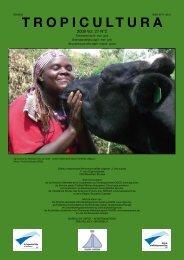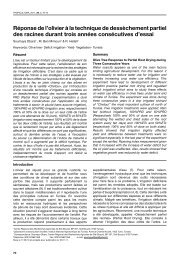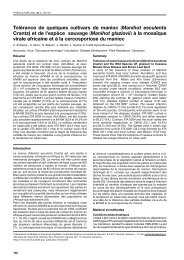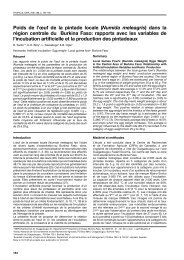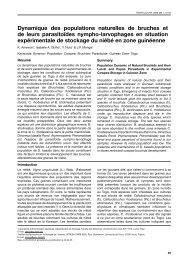Fascicule entier - Tropicultura
Fascicule entier - Tropicultura
Fascicule entier - Tropicultura
Create successful ePaper yourself
Turn your PDF publications into a flip-book with our unique Google optimized e-Paper software.
TROPICULTURA<br />
a maximum of 4 months only. Despite the fact that<br />
powders from mixture of several dried parts of many<br />
botanical species are more effective than those from<br />
a single plant application, there is however, a paucity<br />
of information on the toxicological levels of botanical<br />
admixtures on stored grains, and environment and<br />
human health; and this may restrict usage of plant<br />
powders. Since phytochemicals are organics in<br />
nature, they are assumed to be easily biodegradable,<br />
and thus their field/storage application (manipulation)<br />
may greatly be reduced than manipulating synthetic<br />
insecticides that pollute the environment with many<br />
health risks to human being and living organisms.<br />
The relatively poor performance of farmers’<br />
formulations (doses) may be attributed to insufficient<br />
dosage rates both in quantity and quality. Fresh leaves<br />
contain more moisture than dried ones. The pressure<br />
and action of chemicals compound of plant against<br />
bruchids as antifedants or repellents, are not limited<br />
with fresh leaves.<br />
This study presents strong empirical evidence that<br />
plant powders can delay development and spread of<br />
bruchids within storages. During the evaluation of this<br />
trial, where scientists and farmers shared experience,<br />
members of the two associations were required to<br />
appreciate the difference in approaches experimented<br />
and determine the effective dose per approach. All<br />
farmers admitted that their method of managing bean<br />
bruchids during the conservation in stores was poorly<br />
designed.<br />
1. Anonymous, 2002, Rapport d’activité de la commission d’évaluation<br />
des pertes dans les denrées stockées crées à l’issue du Congrès de<br />
Marseille sur la protection des cultures tropicales. Agronomie tropicale,<br />
24, 872-878.<br />
2. Agona J.A., Owera-Odom F., Kyamanwya S., Silim Nahdy M. & Willson<br />
H.R., 2001, Field management of bruchids on beans using selected<br />
phytochemicals, insecticides and entomopathogen. African Crop Science<br />
Conference Proceedings, 5, 153-157.<br />
3. Bagalwa M., Munyuli Bin M. & Mweze Z., 1999, Activité insecticides de<br />
quelques plantes médicinales du Kivu, contre le Cosmopolites sordidus<br />
(Coleoptera: Curculionidae), ravageur principal du bananier à Iko,<br />
Sud-Kivu. R.D. Congo. Recherches Africaines, 4, 45-52.<br />
4. Dent D., 2000, Insect Pest Management. CABI Bioscience, UK, 410 pp.<br />
5. Donald L.M.C., Guy R.H. & Speirs R.D., 1970, Preliminary evaluation<br />
of new candidates’ materials as toxicants, repellents and attractants<br />
against stored product insects. Marketing Research. Rep. 882. Agric.<br />
Research Service, USD Dept of agriculture, Wasginton, DC.<br />
6. Munyuli B.M. & Balezi N., 2001a, Utilisation des poudrages des plantes<br />
médicinales à propriétés insecticides dans la protection des semences<br />
et denrées alimentaires stockées (haricot, mais & sorgho) contre les<br />
coléoptères ravageurs des stocks, au Kivu, RDCongo. African Crop<br />
Science conference proceedings, 5, 293-303.<br />
7. Munyuli T.M.B. & Balezi N., 2001b, Tuteurage du haricot volubile<br />
(Phaseolus vulgaris L.) par le mais (Zea mays L.) dans une association<br />
culturale de haricot- mais- manioc à Katana, Sud-Kivu, République<br />
Démocratique du Congo. African Crop Science Conference Proceedings,<br />
5, 985-990.<br />
8. Munyuli T.M.B., 2001a, Farmer’s perception of bean pest problems<br />
in Kivu area, Democratic Republic of Congo. African Crop Science<br />
182<br />
Literature<br />
Farmers requested training on the formulation of the<br />
effective dose from the “scientific method”. Training<br />
was organized for them. Members of other associations<br />
were invited and associated to the events. On-storage<br />
demonstrations, field days, shows, exchange visits/<br />
discussion were organized to strengthen the “farmerslearning-from<br />
other farmers” system as one of the<br />
tools to support communities development in Kivu<br />
provinces of DRC. During the training, many other<br />
farmers (non-bean growers) from several villages were<br />
also associated. Concerning the issue of sustainable<br />
bean bruchids management in Kivu provinces of<br />
eastern DRC, it seems to be important to asses the<br />
spread rates of technologies adoption. There is also<br />
a need to conduct socio-economic impact studies of<br />
the technology disseminated among bean growers.<br />
Acknowledgment<br />
We thank Mr Bisusa, coordinator of ADEA, Mr R.<br />
Bashige, coordinator of JAK, extension staffs and<br />
village chiefs for their cooperation in this study. All<br />
associations’ members who participated in the trials<br />
are also acknowledged. We are grateful to CIAT/<br />
PABRA-ECABREN for funding this study. Finally, we<br />
also thank the laboratory technicians Bwema (CRSN-<br />
Lwiro) and Koleramungu (INERA-Mulungu) for their<br />
technical assistance during data collection. We also<br />
thank M. Nkonko, National bean research program<br />
coordinator based at INERA-Mulungu research<br />
station, for providing useful information about bean<br />
varieties cultivated by farmers in eastern D R Congo.<br />
Conference Proceedings, 5, 705-713.<br />
9. Munyuli T.M.B., 2002, Local inhabitants’control strategies of crop pests<br />
in eastern Democratic Republic of Congo, by exploiting the local plant<br />
diversity species. Delpinoa Italy, 44, 65-74.<br />
10. Munyuli T.M.B., 2003, Effet de différentes poudres végétales sur<br />
l’infestation des semences de légumineuses et de céréales au cours de<br />
la conservation au Kivu, République Démocratique du Congo. Cahiers<br />
Agricultures France, 12, 1, 23-31.<br />
11. Munyuli T.M.B., Balezi N. & Musakamba M., 2005, L’utilisation des<br />
poudrages de plantes médicinales dans la lutte contre les bruches du<br />
haricot au Kivu. PABRA Millennium Workshop. Novotel Mount Meru,<br />
Arusha, Tanzania. 28 May–1st June 2001. PABRA (Pan Africa Bean<br />
Research Alliance)/ECABREN (Eastern and Central Africa Bean Research<br />
Network)/ SABRN (Southern Africa Bean Research Network), Pp: 292-<br />
300.<br />
12. Munyuli T.M.B., Luther G.C. & Kyamanywa S., 2007, Effects of cowpea<br />
cropping systems and insecticides on arthropod predators in Uganda<br />
and Democratic Republic of the Congo. International Journal of Crop<br />
Protection, 26, 114-126.<br />
13. Munyuli T.M.B., Luther G.C. & Kyamanywa S., 2008, Effects of groundnut<br />
genotypes, cropping systems and insecticides on the abundance of<br />
native arthropod predators from Uganda and Democratic Republic of<br />
the Congo. Bulletin of Insectology, 67, 1, 11-19.<br />
14. Munyuli T.M.B., Kyamanywa S. & Luther G.C., 2008, Capability of<br />
Forficula auricularia L. (Dermaptera: Forficulidae) to prey on Aphis<br />
craccivora K. (Homoptera: Aphididae) in eastern and central Africa.<br />
Agronomie Africaine, 20, 1, 57-66.<br />
15. Ofuya T.I., 1986, Use of wood as, dry chill pepper fruits and onion scale<br />
leaves for reducing Callobruchus maculates (F) damage in cowpea seeds



